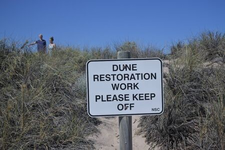
Adelaide’s coast was once a vast sand dune system formed over thousands of years. Waves and currents in the gulf pushed sand northwards, eroding the southern beaches, and the dunes supplied replacement sand as well as a buffer for much of the wave energy. European settlers, unaware of this natural cycle, disrupted the process by building on top of the dunes and locking the sand away. Some dunes were used to infill coastal back swamps to provide land for housing and the airport. Storms continued to erode the beach and it was predicted the southern beaches would soon disappear.
Currently, we have some remnant sand dunes remaining, but we must look after them. Native coastal plants in dunes help to hold the sand in place and reduce erosion of the dunes by large waves and wind. Sand drift fencing, seen at Henley Beach, is another strategy used to keep the sand in place where vegetation has been lost. By walking on the sand dunes, some of these native plants can be trampled. Loss of plants and their root systems, as well as the movement of sand by walking through it, can accelerate erosion and the damage to these remnant sand dunes.
These ecosystems can also be home to many native creatures, such as lizards, insects, birds and even snakes. Keeping off of the dunes can reduce any disturbance to native wildlife, while also avoiding any possibility of encountering a snake on your next beach visit. Additionally, if you walk your dog at the beach, please keep them on a lead and away from the dunes to avoid any disturbance to animals.

In order to preserve our wonderful coastal habitats, please enjoy these sand dune environments from a distance; keep to designated pathways and pay attention to signs where revegetation projects are taking place. You can also do your part by joining environmental volunteering groups in dune revegetation projects through local councils or Friends of Parks groups.
Thank you for caring for our local coastal environment.